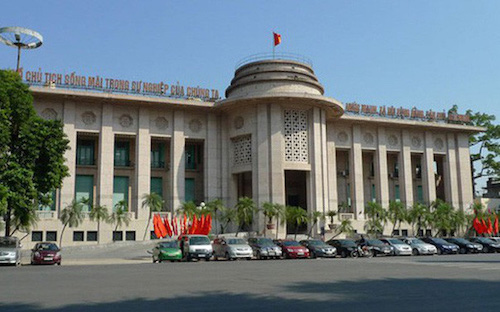The central bank’s decision to lower the interest rates by 0.2-0.5 percentage points on November 19 is a happy augury for businesses.

“Because it is small, our company does not expect to get much benefit from the State Bank of Viet Nam’s recent decision to cut all its key interest rates, but we still appreciate the central bank’s efforts since it makes us feel more optimistic,” Truong Thi Thuy Lien, director of Lien Phat Ltd Company, based in the southern province of Binh Duong, said.
Lien Phat has only borrowed a few billion dong from the bank at an interest rate of nearly 9 per cent.
But the central bank’s decision to lower the interest rates by 0.2-0.5 percentage points on November 19 is a happy augury for businesses, especially those with big loans since they could significantly cut costs, according to Lien.
Under its decision issued on November 18 the SBV has cut the ceiling interest rate on non-term deposits and those of less than one month from 1 per cent to 0.8 per cent. The cap on deposits of one to six months has reduced by 0.5 percentage points to 5 per cent.
The rates on deposits of six months and more will be set by banks themselves based on the market.
The central bank has also cut interest rates on loans to priority sectors.
Short-term loans to agriculture, supporting industries, small and medium-sized enterprises, and the technology sector have seen the interest rate cut from 6.5 per cent to 6 per cent.
Loans from microfinance organisations are now capped at 7 per cent, down from 7.5 per cent.
Responding to the central bank’s move, several banks have also announced cuts to both deposit and loan interest rates.
On September 19 Maritime Bank cut interest rates by 2 percentage points to 6.99 per cent for three-month loans and 7.99 per cent for six-month loans.
ACB cut its rates by 0.2-0.4 percentage points for less than six month loans to 5 per cent per year.
Vietcombank and VietinBank, two of Vietnam’s ‘Big 4’ state-owned lenders, which are the four banks with the highest total assets, reduced deposit rates by 0.2 percentage points for term deposits of under 9 months.
Vietcombank also cut its interest rates on dong loans by 0.5 percentage points.
Mid-sized lenders like Military Bank, TPBank, Eximbank, and VietCapital Bank have announced cuts in short-term deposit rates by 0.1-0.2 percentage points.
Senior bank executives said the central bank’s decision to lower both the deposit and loan ceiling interest rates is aimed at stopping the race between banks to hike deposit interest rates.
Pham Ngoc Hung, vice chairman of the HCMC Enterprises Association, said lowering lending interest rates at this time was of great significance especially for businesses since many of them were in dire need of capital for stocking up for the upcoming peak shopping season.
The rate cuts would also help them feel more secure about making business plans for next year, he said.
The director of an agriculture company in Tien Giang Province said with the new interest rates his company was likely to reduce loan interest expenses by around VND1 billion a year.
The amount might not be much for a large company but would be very significant for small and medium-sized enterprises like his, he said.
The lower costs would improve the competitiveness of Vietnamese products in overseas markets, he added.
State firms look to speed up divestment of stakes in other companies
The Ha Noi Stock Exchange recently announced an auction of 3.2 million shares of the Ha Noi Synthetic Paint Joint Stock Company (HasynpaintCo) by the Viet Nam National Chemicals Group (Vinachem) on December 5.
HasynpaintCo was equitised in 2006, and Vinachem is one of its biggest shareholders with its 3.2 million shares accounting for 27 per cent of the capital.
Vinachem’s decision to sell all its shares at HasynpaintCo is part of its divestment plan for the 2017-20 period, under which it was to sell its stakes in 15 enterprises in 2018, 14 in 2019 and four in 2020.
But it failed to achieve the 2018 target.
So, since the beginning of this year, Vinachem has had to sell its stakes in many companies in which it was a significant shareholder.
They included Sao Vang Rubber Joint Stock Company in which it held a 15 per cent stake and sold it to four investors for VND195.5 billion ($8.5 million) through an action in June, the Da Nang Rubber Joint Stock Company in which it sold 17.23 million shares for VND434 billion and the Southern Fertiliser Joint Stock Company in which it sold 13.9 million shares.
Power Generation Corporation 3 (Genco 3) recently announced plans to auction its stakes in the Vinh Son-Song Hinh Hydropower Company this quarter.
At the end of last year Genco 3 owned 63 million shares or 30.55 per cent of VSH’s charter capital.
It is also making preparations to divest its stakes in two other companies, the Viet Lao Power Joint Stock Company and the Nhon Trach Thermal Power Joint Stock Company.
But in spite of their earnest efforts, many State-owned corporations have found it difficult to achieve their divestment targets.
According to Prime Minister’s Decision No 232/QD-TTg issued in August 2017, 62 State units were to have sold their stakes in other companies this year.
But as of the end of the second quarter only nine did. Of the VND1.657 trillion (US$72.04 billion they collected, VND1.587 trillion($69 billion) came from the sale of stakes in just one company, Viglacera.
Speaking at the 2019 Viet Nam Mergers and Acquisitions Conference, Le Song Lai, deputy general director of sovereign fund, the State Capital Investment Corporation, said the state capital divestment progress had been slow in the last two years.
What ails State companies’ divestment plans?
Analysts blamed this on several reasons like reluctance on the part of their managements since the divestment would result in losses, especially for businesses who are not doing well, and the failure of many equitised enterprises to list on the stock market.
A report by the Ministry of Finance showed 667 enterprises had been equitised but not listed as of last year.
The failure to list also resulted in their lax supervision.
Experts said many businesses were not aware of the benefits of listing.
Land use rights are another problem plaguing divestment efforts. Many companies lack legal documents to prove their land use rights while lands are often their most valuable assets.
The Government should take drastic action to disinvest to mobilise resources for development and reducing public debts, they said.
To achieve the divestment targets ministries and local administrations should instruct firms to proactively look to settle their problems, they added.— VNS





